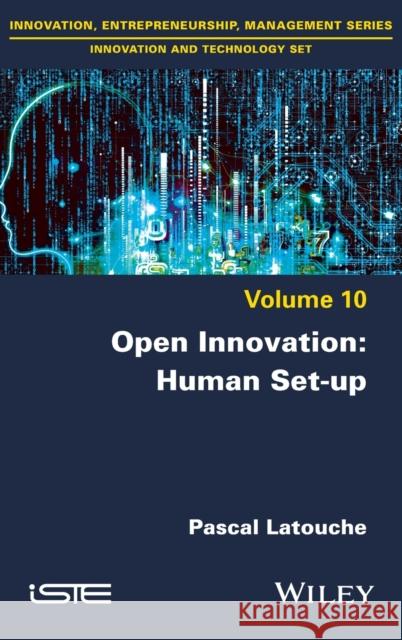Open Innovation: Human Set-Up » książka



Open Innovation: Human Set-Up
ISBN-13: 9781786305756 / Angielski / Twarda / 2020 / 272 str.
Open Innovation: Human Set-Up
ISBN-13: 9781786305756 / Angielski / Twarda / 2020 / 272 str.
(netto: 721,48 VAT: 5%)
Najniższa cena z 30 dni: 736,79
ok. 16-18 dni roboczych
Dostawa w 2026 r.
Darmowa dostawa!
Acknowledgments xiPreface xiiiIntroduction xvPart 1. Multiple Journeys 1Introduction to Part 1 3Chapter 1. Mr. José Jacques Gustave, the Global Entrepreneur! 51.1. Context 51.1.1. Parents-warrior 51.1.2. Difficult school years 71.1.3. An asserted curiosity 71.2. The little voice inside 81.2.1. The journey of awakening 81.2.2. Reconciliation 91.2.3. Values 91.3. The fool with the hands full 101.3.1. A network 101.3.2. Convictions 111.3.3. A thirst to move forward 11Chapter 2. Mrs. Cindy Dorkenoo, No Destiny, Only What She Does! 152.1. Context 152.1.1. "Classic" parents 162.1.2. Boring education 162.1.3. The period of studies 172.2. From employment to entrepreneurship 182.2.1. Not made for wage-earning 182.2.2. Full-time entrepreneurship 192.2.3. Naïas, a means and not an end 20Chapter 3. Mrs. Elodie Sarfati, a Brownian Journey! 233.1. Context 233.1.1. A modest and open environment 243.1.2. Quiet schooling 243.1.3. Studies 253.2. Time to build 253.2.1. A student entrepreneur 253.2.2. Back to employment 263.2.3. Getting started 27Chapter 4. Mrs. Chrystèle Sanon, "A Schizophrenic Who Treats Herself?" 294.1. Context 294.1.1. The origins 294.1.2. A voluntary journey 304.1.3. Towards working life 304.2. From employment to entrepreneurship 314.2.1. The emergence of an entrepreneur 314.2.2. Her first entrepreneurial experience 314.2.3. FULL'STREET, the launch 32Chapter 5. Mr. Christophe Vattier, the Lucky Rebel! 355.1. Context 355.1.1. Origins 365.1.2. Teenage years of disruption 365.1.3. A dream student life 375.2. From employment to entrepreneurship 385.2.1. Classical wage earning 385.2.2. Entrepreneurial wage earning 385.2.3. Pure entrepreneurship 39Chapter 6. Mrs. Lise Bellavoine, When Entrepreneurship Becomes an Art! 416.1. Context 426.1.1. Nothing but nature 426.1.2. A poet 426.1.3. The loop 436.2. Employment to entrepreneurship 446.2.1. Paid employment 446.2.2. The trigger 456.2.3. Entrepreneurship 46Chapter 7. Ms. Laura Nordin, the Paradigm Shift? 497.1. Context 497.1.1. Middle-class background 507.1.2. Standardized education 507.1.3. Easy schooling and education under influence 517.2. From employment to entrepreneurship 517.2.1. In the family business 517.2.2. Reconversion 527.2.3. Minut'Prod 53Conclusion to Part 1 55Part 2. Marrying Two "Mindsets" 57Introduction to Part 2 59Chapter 8. Effectuation Vs. Causation 618.1. From beliefs to paradigms 628.1.1. Predicting the future to better control it (old paradigm) 638.1.2. Controlling the future to better prevent it (new paradigm) 658.1.3. Saras Sarasvathy's effectuation theory 678.2. From one mode to another 718.2.1. Criticisms of causation 718.2.2. The first principle 748.2.3. The other principles 768.3. From one world to another 788.3.1. The raw unfiltered reality 798.3.2. The operational team of a business unit 818.3.3. Similarities and differences 83Chapter 9. One Stage, Two Headliners 879.1. The distribution of roles 889.1.1. The corporate open innovation structure as a stage 889.1.2. Mr. X, in the role of a business unit employee 909.1.3. Mr. S, in the role of the start-up's CEO... 929.2. The difficulties of the script 949.2.1. Mr. X and Mr. S, the millefeuille effect 959.2.2. Mr. X and Mr. S, the swarm effect... 959.2.3. Mr. X and Mr. S, the "not invented here" effect... 989.2.4. Mr. X and Mr. S, the "It's up to me" effect... 999.3. The recurrence of obstacles 1009.3.1. One thing, multiple views 1009.3.2. The not guilty silences 1029.3.3. Those who decidedly didn't understand anything 1039.3.4. The unwilling pirates 105Chapter 10. Two Ecosystems 10910.1. The ecosystems in question 10910.1.1. The external ecosystem (of start-ups) 11110.1.2. The internal ecosystem (of the large group) 11410.1.3. External ecosystem vs. internal ecosystem 11610.2. Actors' behavior 11810.2.1. Three attitudes or behaviors 11810.2.2. Some polemical illustrations 12010.2.3. Collaboration to oil the wheels 12210.3. Associated risks 12410.3.1. The source of risks 12410.3.2. Fiscal risk 12510.3.3. HR risk 12510.3.4. Security risk 12610.3.5. Compliance risk 12610.3.6. Purchasing risk 12710.3.7. Image risk 12810.3.8. Intellectual property risk 128Conclusion to Part 2 131Part 3. The Mysteries of the Profession 133Introduction to Part 3 135Chapter 11. Skills and Influences 13711.1. "Hard" skills or situational intelligence 13811.1.1. Benevolent control 13811.1.2. Understanding the organizational microcosm 14011.1.3. Knowing how to problematize 14211.1.4. Tips and tricks to develop your "hard" skills 14411.2. Soft skills or people's intelligence 14611.2.1. The art of advocacy 14711.2.2. The art of defining 14811.2.3. The art of motivating 15011.2.4. The art of building an identity network 15111.2.5. The art of changing norms 15211.2.6. Tips and tricks to develop your "soft" skills 15411.3. Acting with your skills 15511.3.1. Relative advantages 15611.3.2. Complexity 15711.3.3. Functional ambiguity 157Chapter 12. Useful Resources 16112.1. Useful human resources 16112.1.1. Human management 16212.1.2. Business developers 16512.1.3. Ecosystem management 16712.1.4. Digital communication 17012.2. Useful "non-human" resources 17112.2.1. The basis 17112.2.2. Going further 17212.2.3. The real false costs 17212.3. Misuse... 17312.3.1. Misuse from start-ups 17412.3.2. Misuses from the large group 17612.3.3. Corporate open innovation, this human misuse? 178Chapter 13. Operation Principles 18113.1. Social operating principles (social functioning) 18213.1.1. Social principle 1: situational intelligence 18213.1.2. Social principle 2: people's intelligence 18413.1.3. Social principle 3: the intelligence of moments 18713.2. Structural operating principles (structural operation) 18913.2.1. Structural principle 1: the "corporate network" dimension 19013.2.2. Structural principle 2: permanent iterations 19213.2.3. Structural principle 3: "learning by doing" 19413.3. Business principles of operation (business functioning) 19613.3.1. The events 19613.3.2. Satisfaction 19813.3.3. Direct values 200Conclusion to Part 3 205Conclusion 207References 211Index 225
Pascal Latouche, Doctor and Open Innovation expert, Director of Orange Fab France and coordinator of a network of 16 Fabs on 4 continents.
1997-2025 DolnySlask.com Agencja Internetowa
KrainaKsiazek.PL - Księgarnia Internetowa









